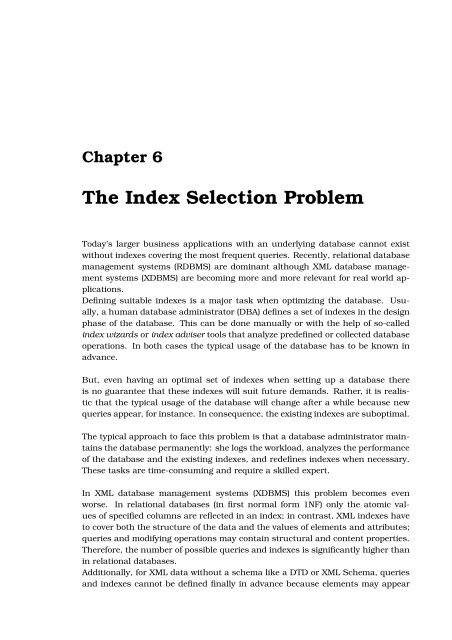url - Universität zu Lübeck
url - Universität zu Lübeck
url - Universität zu Lübeck
You also want an ePaper? Increase the reach of your titles
YUMPU automatically turns print PDFs into web optimized ePapers that Google loves.
Chapter 6<br />
The Index Selection Problem<br />
Today’s larger business applications with an underlying database cannot exist<br />
without indexes covering the most frequent queries. Recently, relational database<br />
management systems (RDBMS) are dominant although XML database management<br />
systems (XDBMS) are becoming more and more relevant for real world applications.<br />
Defining suitable indexes is a major task when optimizing the database. Usually,<br />
a human database administrator (DBA) defines a set of indexes in the design<br />
phase of the database. This can be done manually or with the help of so-called<br />
index wizards or index adviser tools that analyze predefined or collected database<br />
operations. In both cases the typical usage of the database has to be known in<br />
advance.<br />
But, even having an optimal set of indexes when setting up a database there<br />
is no guarantee that these indexes will suit future demands. Rather, it is realistic<br />
that the typical usage of the database will change after a while because new<br />
queries appear, for instance. In consequence, the existing indexes are suboptimal.<br />
The typical approach to face this problem is that a database administrator maintains<br />
the database permanently: she logs the workload, analyzes the performance<br />
of the database and the existing indexes, and redefines indexes when necessary.<br />
These tasks are time-consuming and require a skilled expert.<br />
In XML database management systems (XDBMS) this problem becomes even<br />
worse. In relational databases (in first normal form 1NF) only the atomic values<br />
of specified columns are reflected in an index; in contrast, XML indexes have<br />
to cover both the structure of the data and the values of elements and attributes;<br />
queries and modifying operations may contain structural and content properties.<br />
Therefore, the number of possible queries and indexes is significantly higher than<br />
in relational databases.<br />
Additionally, for XML data without a schema like a DTD or XML Schema, queries<br />
and indexes cannot be defined finally in advance because elements may appear
















